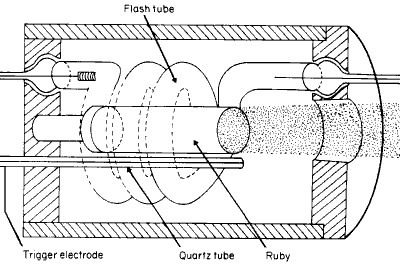 Dr. T H Maiman
with the first ruby laser
Dr. T H Maiman
with the first ruby laser
The broadband optical pumping of a synthetic pink ruby crystal using a flash lamp
is capable of raising a substantial fraction of the chromium ions to the upper laser level.
(Maiman, 1960).
Initially it was thought that broadband optical pumping would be inefficient but this was only for ions with very narrow resonances such as those in gases and plasmas. When ions are embedded in a solid, they can absorb radiation in a much wider band of wavelengths. Optical radiation of about 550 nanometers is absorbed by dilute population of Cr+3 ions lightly doped in a corundum crystal matrix (0.05% by weight Cr2O3 versus Al2O3 ) then a rapid non-thermal transition is made to a lower metastable level whose lifetime is 5 milliseconds. If the pump power exceeds a certain threshold, a population inversion can build up between the ground state and this metastable state. The laser's performance is greatly improved by enclosing it in an optical resonator.
 The first successfully optical laser constructed by
Maiman
(1960), consisted of
a ruby crystal surrounded by a helicoidal flash tube enclosed within a polished
aluminum cylindrical cavity cooled by forced air.
The ruby cylinder forms a Fabry-Perot cavity by optically polishing the ends to be
parallel to within a third of a wavelength of light. Each end was coated with
evaporated silver, one end was made less reflective to allow some radiation to
escape as a beam.
The first successfully optical laser constructed by
Maiman
(1960), consisted of
a ruby crystal surrounded by a helicoidal flash tube enclosed within a polished
aluminum cylindrical cavity cooled by forced air.
The ruby cylinder forms a Fabry-Perot cavity by optically polishing the ends to be
parallel to within a third of a wavelength of light. Each end was coated with
evaporated silver, one end was made less reflective to allow some radiation to
escape as a beam.Photo-pumped by a fast discharge flash-lamp, the first ruby lasers operated in pulsed mode for reasons of heat dissipation and the need for high pumping powers. Nelson and Boyle (1962) constructed a continuous lasing ruby by replacing the flash lamp with an arclamp.
 Dr. T H Maiman
with the first ruby laser
Dr. T H Maiman
with the first ruby laser